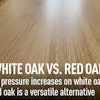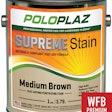The popularity of eco-friendly products touches nearly every part of the U.S. economy, and the hardwood flooring industry is certainly no exception. Consider Americans' keen interest in alternative flooring products such as those made of cork or bamboo, or the rising demand for traditional flooring products certified by the FSC (Forest Stewardship Council). Likewise, consumers these days are far more receptive to the environmental drawbacks of carpet: A generation ago, few people other than scientists knew about VOCs (volatile organic compounds), but today some Americans are concerned about the possibility that their living room rugs are harboring allergens and releasing dangerous compounds.
Thanks to the green movement, the hardwood flooring industry is constantly playing both defense and offense on the environment. Companies are under the gun to highlight whatever eco-friendly qualities their products might possess, and they feel the need to compare their own products against various alternatives available in the marketplace. As the hardwood flooring industry engages in these green marketing efforts, though, it must carefully consider the risks associated with doing so. In today's regulatory environment, even seemingly modest claims can carry legal risks. Indeed, in recent years the Federal Trade Commission (FTC) has been more closely scrutinizing marketers' green claims under the FTC Act, which gives regulators the mandate to ferret out unfair, deceptive or unsubstantiated environmental claims.
'Green Guides'
Specific compliance guidelines can be found in the FTC's "Green Guides," first issued in 1992 and now under revision. While a high-ranking source within the agency says the final revised g4uides will not be issued for several more months, the FTC has already provided some revealing details about its upcoming plans-and the hardwood flooring industry should take careful note of these proposed changes.
As outlined thus far, the revisions strongly emphasize that all marketing messages should be "clear and prominent." At a glance, the consumer should be able to tell whether the particular claims apply to the product, the packaging or just a component of either. If a particular hardwood flooring product does offer some environmental benefit worth touting, the proposed revisions make clear that marketers must not overstate the claim. It is always dangerous to make any general, environmental benefit claim unless you have competent, reliable evidence to back it up. Catch-all terms such as "green" and "eco-friendly" are all but meaningless in the eyes of the FTC. Indeed, regulators have signaled that unqualified, general environmental benefit claims are difficult, if not impossible, to substantiate and should therefore be avoided. Marketers should also limit their claims to those that are specific and quantifiable: Rather than describe a particular hardwood flooring product as "eco-friendly," for example, take a just-the-facts approach-e.g., "reclaimed from factory flooring and beams."
While the FTC has yet to take any enforcement action against any company in the wood flooring industry for deceptive green claims, an example from elsewhere in the building products world shows how the FTC wants companies to back marketing claims instead of relying on vague statements to sell products. In May, the FTC reached final settlement agreements with five companies that make and sell windows. The agency charged that the companies made overblown energy-efficiency and cost-savings claims-including promising consumers they could save "up to" specific amounts of money on their heating and cooling bills by having new windows installed. The final orders prohibited the companies from making these claims without proper documentation.
Certifications & Seals
Not so long ago, marketers of flooring products competed only on the likes of price and appearance. Today, they must one-up the competition on the green factor, as well, which might increase the temptation to tout this or that environmental certification or seal. However, one of the most significant changes in the proposed Green Guides is a new section on the use of environmental certifications and seals of approval in advertising.
This is of particular interest to the hardwood flooring industry, which relies heavily on certifications. In the eyes of the FTC, it is important to note, any sort of certification or seal is equal to an endorsement and, as such, is covered by the previously issued FTC Endorsement Guides, which spell out the need for substantiation of all claims mentioned in an endorsement or testimonial. Whatever that certification or seal of approval happens to say, it must be truthful and substantiated. The FTC's intent on this score was illustrated last year when the agency announced it had reached a consent agreement with Nonprofit Management LLC and its owner, whom regulators accused of offering a deceptive "Tested Green" environmental certification to any business willing to pay for the honor.
Likewise, a "seal of approval" does not relieve the marketer of the duty to substantiate all claims conveyed by the certification, whether expressed or implied. In dealing with makers of hardwood flooring products, regulators will take a dim view of excuses such as, "Well, if this isn't truthful, it is the seal-giver's fault."
The Advertising Stream
As they negotiate these dynamics, flooring makers should analyze how closely and well their marketing and risk-management teams work together in devising consumer advertisements. And retail dealers should consider this, too, before accepting at face value and running ad copy just because the manufacturer blessed it: Consumer protection regulators can hold liable anyone in the advertising "stream" for false, deceptive or unsubstantiated ad claims. With the FTC closely scrutinizing green claims, it is particularly important that marketers' enthusiasm be balanced against compliance officers' concerns.
The best way to accomplish this is for the two camps to work hand-in-hand on the project from the start. Some companies make unsubstantiated and bullish environmental claims about their products and then, after running afoul of regulators, try to find substantiation after the fact, but the FTC requires substantiation before the claim is made. While a talented graphic designer can, with a few clicks, whip up a verdantly colored ad for, say, a bamboo flooring product, it is a far more daunting proposition to actually back up that ad with legally sound science. As a result, compliance must sometimes put the brakes on marketing. This can create tension, but getting it right is in everyone's best interest in the long run.
Finally, terms such as "free of," "nontoxic," "recyclable" and "compostable" might seem straightforward enough, but the proposed revisions drill into the specific, legally acceptable usage of such language. Want to label a flooring product as "ozone-safe"? Check the Green Guides first.
Proposed revisions for the green guides are available here.































